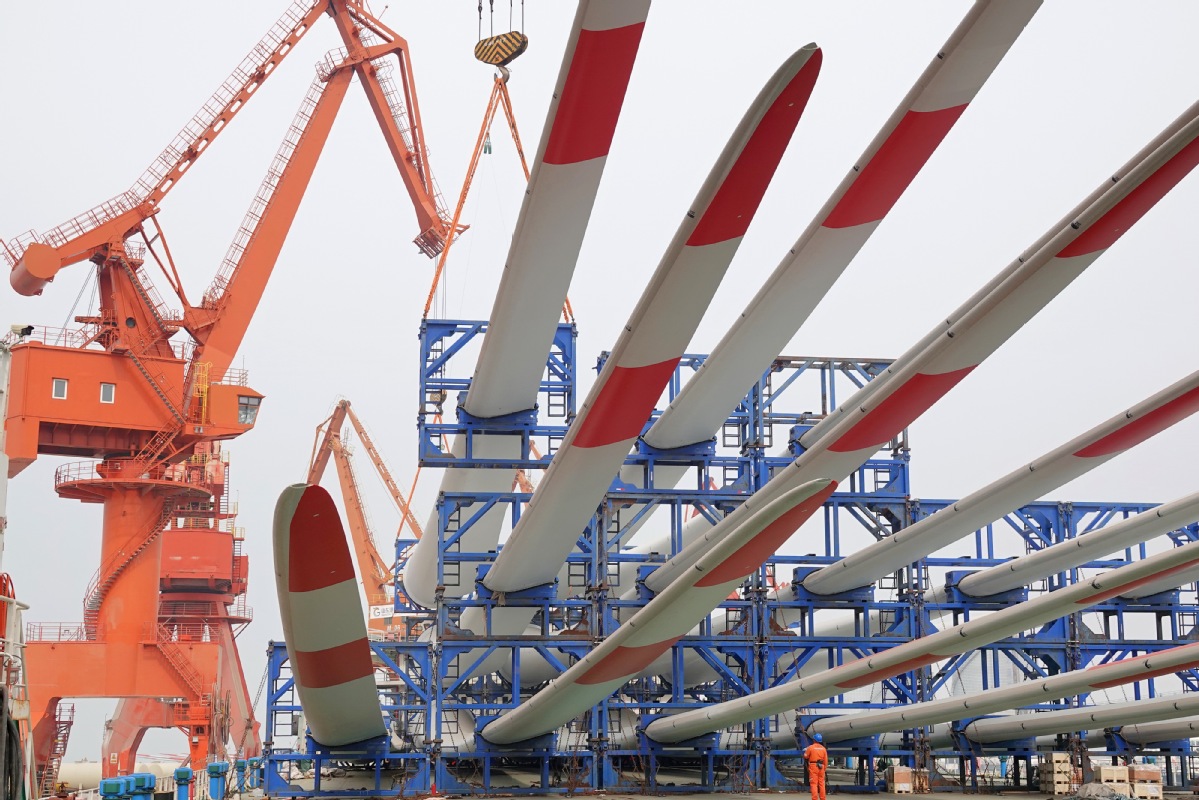
An array of wind turbine blades is loaded onto a vessel at a port in Yantai, Shandong province, in April. TANG KE/FOR CHINA DAILY
Further efforts are in the pipeline to speed up power grid construction and enhance power transmission mechanism, said the National Energy Administration, as China's power grid faces increasing stability challenges with the rising share of electricity generated from intermittent new energy sources.
Experts also called for further efforts to enhance energy storage capacity and leverage new technologies such as smart grids to improve the grid fine-tuning capabilities, mainly for peak shaving and valley filling.
China's installed non-fossil fuel power contributed over 50 percent of last year's total, surpassing that of fossil fuel power for the first time in history. By the end of April, cumulative wind and solar installations in China exceeded 1.1 billion kilowatts, a year-on-year increase of about 38 percent, said the National Energy Administration.
With the increasing proportion of renewable energy resources used for power generation, the grid's absorption of them is facing great challenges. Due to the difficulty of large-scale power storage, power is essentially "generated as needed", making real-time dynamic balance crucial between generators and consumers. However, the inherent variability and intermittency of new energy sources such as wind and solar pose challenges to striking such a balance. The grid's insufficiency in accommodating electricity from new energy resources will result in situations where excess electricity cannot be utilized or transmitted effectively, leading to wastage.
Despite wind and solar power installations exceeding half of the total energy mix, consumption of non-fossil energy only comprised 17.9 percent last year, said the NEA.
"To enhance the grid's capability to accommodate power from new energy sources, we are accelerating the construction of grid projects. This year, we are focusing on advancing the completion of 33 key projects such as the Sichuan-Chongqing ultra high voltage alternating current project. We are also expediting the commencement of construction on 37 key projects," said Du Zhongming, head of the electricity bureau of the NEA, at a recent conference.
Du said the NEA will work to improve the grid's ability to flexibly adjust scheduling of power supply and enhance interprovincial power-sharing capabilities.
"We will also strengthen the construction of the distribution network (that connects the grid to users) to meet the requirements of large-scale development of distributed new energies. By 2025, the distribution network will have the capacity to accommodate approximately 500 million kW of distributed new energies. Furthermore, we have optimized targets for the grid's absorption of power generated from new energy sources, relaxing them to not less than 90 percent in certain regions," Du said.
The new 90 percent absorption rate was announced by the State Council in May.
Previously, the average absorption rate of wind and solar power was set at 95 percent to address the problem of wind and solar power waste during the 13th Five-Year Plan period (2016-20). Areas that fail to meet these standards face restrictions on new project approvals.
However, the increased penetration rate of power from new energies significantly amplified the pressure on its consumption, particularly in provinces with low local electricity demand and insufficient transmission capacity. Some experts argue that power absorption requirements have become constraints on the large-scale development of renewable energies.
"Varying costs were incurred across regions to maintain an absorption rate of 95 percent for wind and solar power in the past. Generally, regions with abundant resources of wind and solar but less demand for electricity in the west and north incurred much higher costs. Scientific formulation and moderate relaxation of renewable energy utilization rates in these regions could release significant new installation space," said Lin Boqiang, head of the China Institute for Studies in Energy Policy at Xiamen University.
"With the easing of these thresholds, more wind and solar power will participate in market transactions instead of being directly absorbed by the grid. However, unstable wind and solar power may not necessarily have an advantage over coal-fired electricity unless generation sides are equipped with energy storage to stabilize unstable power, thereby increasing generating costs. Other measures include the development of smart grids to optimize power distribution."
Source: By Liu Yukun, chinadaily.com, June 26, 2024 [https://www.chinadaily.com.cn/a/202406/26/WS667b6920a31095c51c50ade5.html]

